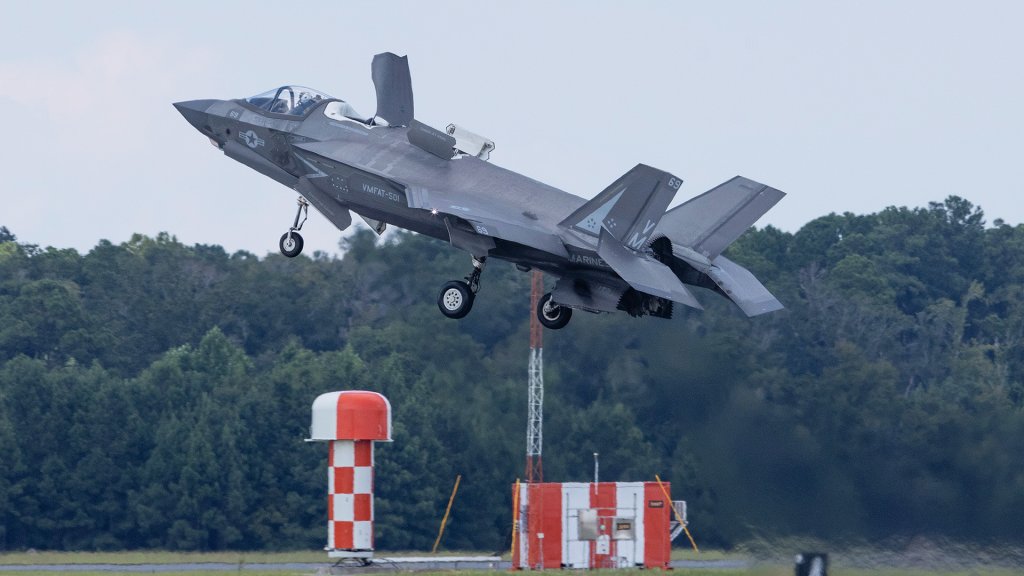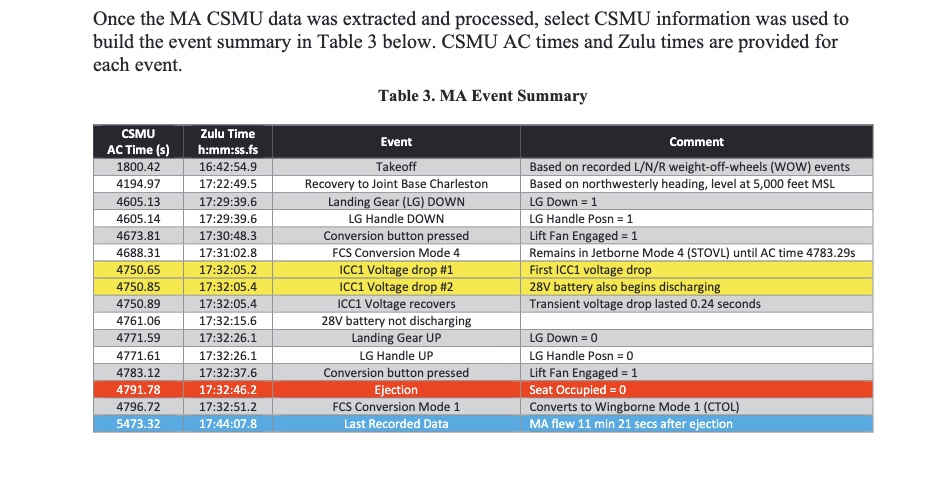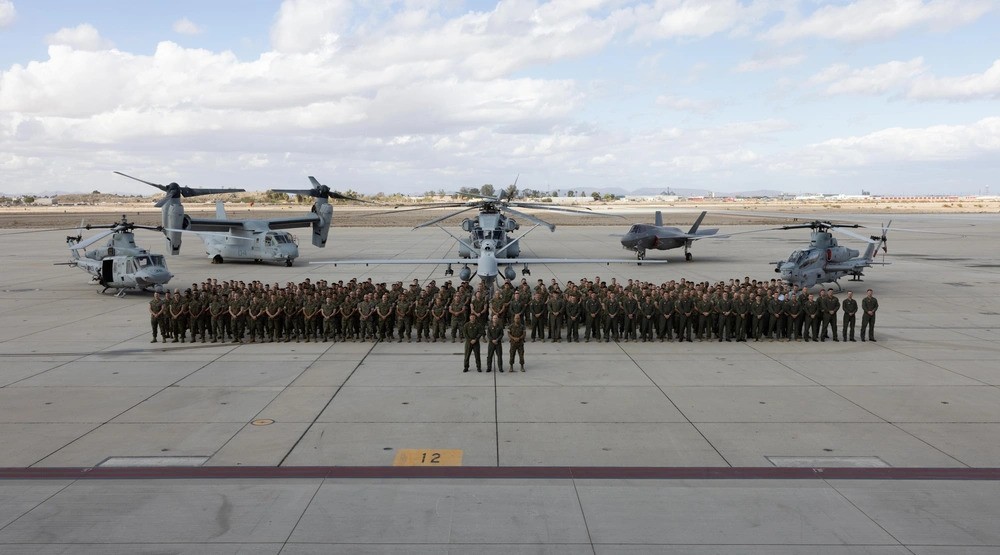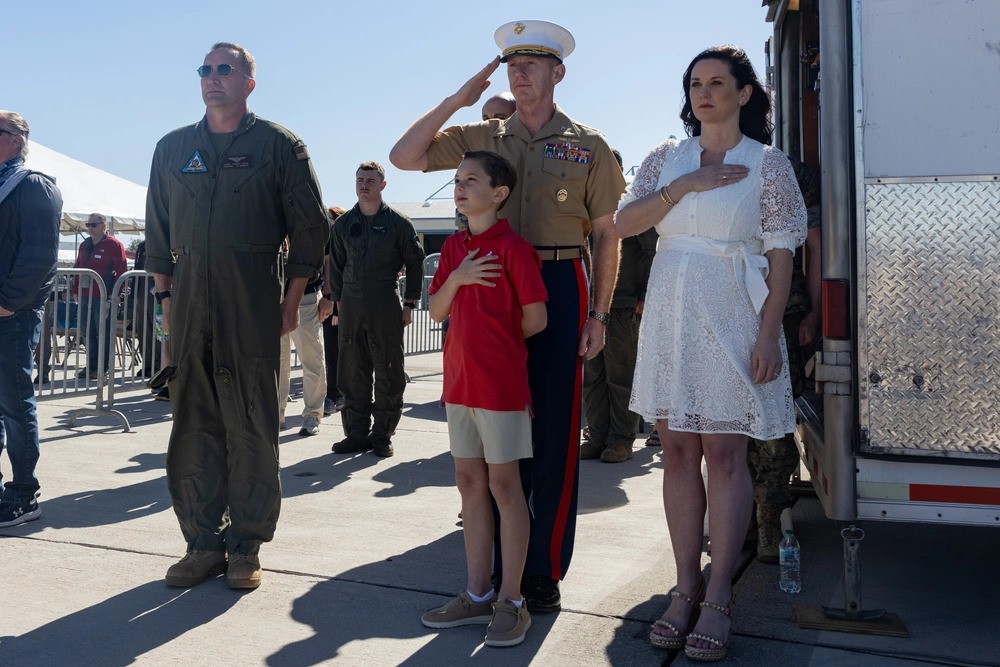The Marines partially blamed Charles “Tre” Del Pizzo for the loss of his F-35B Joint Strike Fighter that flew pilotless for nearly 12 minutes before slamming into the ground following his ejection back in September 2023. Now the 48-year-old retired colonel is giving his side of the story.
In a truly amazing piece by Post and Courier reporter Tony Bartelme, Del Pizzo pushed back on the Marine Corps’ findings, saying he was essentially blinded in bad weather by cascading equipment malfunctions while returning to Joint Base Charleston, South Carolina from a training sortie over the Atlantic Ocean.
Before the incident, Del Pizzo was putting the jet through its paces as he was learning its strengths and weaknesses before taking command of VMX-1, a key operational test and evaluation squadron in Yuma, Arizona. The mishap occurred as Del Pizzo was attempting an instrument landing in the F-35B’s vertical mode in zero-visibility conditions during a raging storm. Unlike the Air Force’s F-35A and the Navy F-35C carrier variant, the B version flown by the Marines possesses short takeoff, vertical landing (STOVL) capabilities, allowing it to take off, land and hover in a manner similar to the AV-B8 Harrier jets that Del Pizza used to fly.
 An F-35B stealth jet like the one piloted by then-Marine Col. Charles Del Pizzo taking off. (Lance Cpl. Kyle Baskin)
An F-35B stealth jet like the one piloted by then-Marine Col. Charles Del Pizzo taking off. (Lance Cpl. Kyle Baskin) Both the Marine Corps’ final report on the mishap and Del Pizzo’s version note problems with the nearly half-million-dollar helmet that displayed the jet’s speed, altitude and targeting information. It is the severity of the malfunctions and how much it contributed to Del Pizzo’s decision to punch out of the aircraft on Sept. 17, 2023 where the two accounts greatly differ. Two other Marine investigations into the incident backed up Del Pizzo’s contention (more on those later).
“Contributing factors to the mishap included an electrical event during flight, which induced failures of both primary radios, the transponder, the tactical air navigation system, and the instrument landing system; and the probability that the helmet-mounted display and panoramic cockpit display were not operational for at least three distinct periods,” the 2nd Marine Aircraft Wing (MAW) stated last year in a press release announcing the results of the third and final investigation into the incident. “This caused the pilot to become disoriented in challenging instrument and meteorological conditions.”
“The investigation concluded that the mishap occurred due to pilot error,” the release continued. “The pilot incorrectly diagnosed an out-of-controlled flight emergency and ejected from a flyable aircraft, albeit during a heavy rainstorm compounded with aircraft electrical and display malfunctions.”
 A timeline of events compiled by the Marines for their Command Investigation into the Sept. 17, 2023 mishap. (USMC)
A timeline of events compiled by the Marines for their Command Investigation into the Sept. 17, 2023 mishap. (USMC) Del Pizzo said he had no choice but to eject. Starting suddenly shortly after 1:30 p.m., the helmet failed three times in 41 seconds, the now-retired Marine pilot stated.
At first, he said his helmet flickered, then “the visor erupted in flashes of alerts,” Bartelme wrote. “Failures in flight control systems, avionics, cooling, navigation, GPS, communications. Audio alerts sounded: whoop, whoop, whoop. Then the helmet and main displays went dark; the audio alerts stopped. About 15 seconds had passed.”
About 15 seconds later, the helmet failed for a second time as the jet was in clouds about 750 off the ground and descending in vertical mode at about 800 feet per second. He opted to execute a “missed approach procedure” and get away from the ground.
Del Pizzo “pulled back the stick to climb, pushed the throttle forward for thrust,” Bartelme wrote. “Raised the landing gear. Pressed a button that converts the jet from vertical mode to conventional. Then the helmet display went dark again, as if rebooting. He tried to radio his wingman, the control tower. Nothing. Coms out. Then it flashed on, along with another thunderstorm of alerts, more than 25 messages telling him that the jet was in deep trouble and getting worse. Whoop, whoop, whoop.”
Just 11 seconds later, the equipment failed again, Del Pizzo stated to Bartelme.
“The helmet and main display failed a third time, differently now, as if powering down for good,” Bartelme wrote. “Instruments gone, a sea of gray outside his window. Is the plane responding? He pulled the throttle back. He glanced at the small backup panel between his legs. He heard what sounded like a motor spooling down. The engine? He felt the nose of the aircraft tilt upward. He felt a falling sensation. He still couldn’t see the ground. Was he still over the base? Over the trees?”
“Forty-one seconds. Decide, act: The jet’s going into the trees, and I’m going with it. In one quick motion, he reached between his legs for the yellow handle, put his left hand over his right wrist. And pulled.”
You can hear audio feeds from emergency responders and air traffic control audio of the incident below.
To go along with the ATC audio put together by Aeroscout, here's the full radio traffic from Charleston County EMS/Fire for the #F35 pilot ejection beginning from the initial dispatch until they cleared the scene.
Units: Medic 8 (Charleston County EMS), Engine 210 (North… https://t.co/zzJiybqlOy pic.twitter.com/6HY4CAg7jF
Del Pizzo was injured by the ejection as shards of metal dug into his neck from the canopy blown open by explosives. He was hurt some more when his helmet and face mask were ripped off by the force of the wind. He also broke his back.
He initially feared he would be killed by the out-of-control jet falling on top of him as both came back to Earth.
“I remember feeling the precipitation on my face, and then just being pulled back as the drogue chute opened and slowed me down,” Del Pizzo noted “And I could hear the engine noise from the airplane. With my helmet off, it was pretty loud. What I heard was complete chaos. Things falling around me. And that’s when I thought the airplane is going to come down and hit me, because I felt like the airplane was out of control, right? I thought the airplane is going to hit me, and I’m going to die here in this parachute.”
However, he said his biggest concern wasn’t for himself.
“Uppermost in his mind as he talked to the dispatcher and arriving paramedics: What happened to the jet?” Bartelme wrote.
“My biggest fear was that I’d hurt someone,” Del Pizzo told him.

Unbeknownst to him at the time, however, the jet continued flying unmanned for another “11 minutes and 21 seconds before impacting in a rural area approximately 64 nautical miles northeast of the airfield in Williamsburg County, South Carolina,” the Marines said in their press release last year. “The investigation concludes the mishap aircraft’s extended unmanned flight was due to stability provided by the F-35’s advanced automatic flight-control systems.”
The aircraft was discovered more than 24 hours later, crashed in a heavily wooded area.
“The mishap resulted in no ground-related injuries, but it did result in property damage in the form of lost forested land and crops,” the Marines noted in their press release.
 Part of the lift fan, nose landing gear, and other debris found in the area where the F-35B impacted the ground. (USMC crash investigation document)
Part of the lift fan, nose landing gear, and other debris found in the area where the F-35B impacted the ground. (USMC crash investigation document) 
The exact cause of the electrical malfunction may never be publicly known, because the Marines redacted it for “national security purposes,” Bartelme pointed out.
“Unredacted portions ruled out some causes, though,” he wrote. “Thunderstorms were in the area, but bolts at the time of the mishap were 20 miles away and couldn’t have fried the plane’s electronics. Investigators noted that the aircraft entered heavy rain five minutes before Del Pizzo ejected. But a Marine spokesperson said its investigation found no evidence that rainwater caused the electrical malfunction.”
The F-35 fleet as a whole experienced issues with lightning over concerns about the aircraft’s fuel system. You can read more about that here.
The Marines’ final investigation report said that “there were no punitive actions recommended” as a result of this mishap. However, more than a year later, the Corps relieved Del Pizzo of command of VMX-1.
 U.S. Marines with Marine Operational Test and Evaluation Squadron (VMX) 1 pose for a photo at Marine Corps Air Station Yuma, Arizona, March 12, 2025. VMX-1 is responsible for assessing all Marine Corps aviation systems and platforms, contributing to the development of Marine aviation tactics, techniques, and procedures. (U.S. Marine Corps photo by Lance Cpl. Christian Radosti)
U.S. Marines with Marine Operational Test and Evaluation Squadron (VMX) 1 pose for a photo at Marine Corps Air Station Yuma, Arizona, March 12, 2025. VMX-1 is responsible for assessing all Marine Corps aviation systems and platforms, contributing to the development of Marine aviation tactics, techniques, and procedures. (U.S. Marine Corps photo by Lance Cpl. Christian Radosti) The decision was made even though two of three Marine investigations into the incident concluded that Del Pizzo was not at fault, the Post and Courier explained. That conclusion was based on statements from Del Pizzo, officials knowledgeable about the reports’ contents and documents obtained by the publication through open records laws.
“Del Pizzo’s aircraft experienced a significant electrical malfunction, one that knocked out key systems — including displays and navigation aids he needed to land in severe weather,” the newspaper noted. “Knobs to radios weren’t working, making it difficult to contact air traffic controllers or his wingman for guidance. A small backup display was partially functional, but Del Pizzo had to look down to see it.”
This and the zero-visibility conditions “likely contributed to a phenomenon known as spatial disorientation, where your inner ear tricks you into feeling that you’re dizzy or falling,” Bartelme’s story continued.
The Navy Aviation Mishap Board and the Field Flight Performance Board “each noted that nothing in the military’s training and simulator work prepared pilots for a crescendo of systems failures in severe weather at a low altitude,” according to the Post and Courier. “In fact, the F-35B’s flight manual said, ‘the aircraft is considered to be in out of controlled flight (OCF) when it fails to respond properly to pilot inputs,” adding, “if out of control below 6,000 feet AGL (above ground level): EJECT.’”
Both of those investigations concluded that most highly experienced pilots with similar levels of experience in an F-35 would have punched out of the plane. One even lauded Del Pizzo for his handling of the event. After the accident, superiors also praised Del Pizzo for his command of VMX-1
Still, last October, he was suddenly and immediately relieved of command, based on the service’s Command Investigation, the third of the three that looked into the accident, Bartelme reported. The Marines explained the sudden and immediate relief of command was due to a “loss of trust and confidence.”
Del Pizzo, caught off guard and hurt by the decision, opted to retire given that his future options in the Corps would be severely limited.
 U.S. Marine Corps Col. Jared K. Stone, left, commanding officer, Marine Corps Air Station (MCAS) Yuma, and Retired Col. Charles W. Del Pizzo and his family conduct the proper procedures during the playing of the national anthem during the opening ceremony of the Yuma Airshow at MCAS Yuma, Arizona, March 15, 2025. During the Yuma Airshow, Del Pizzo was honored for 32 years of service. (U.S. Marine Corps photo by Cpl. Jade K. Venegas)
U.S. Marine Corps Col. Jared K. Stone, left, commanding officer, Marine Corps Air Station (MCAS) Yuma, and Retired Col. Charles W. Del Pizzo and his family conduct the proper procedures during the playing of the national anthem during the opening ceremony of the Yuma Airshow at MCAS Yuma, Arizona, March 15, 2025. During the Yuma Airshow, Del Pizzo was honored for 32 years of service. (U.S. Marine Corps photo by Cpl. Jade K. Venegas) Asked by The War Zone for a response to the Post and Courier story, the Marines offered the following:
“The Commandant of the Marine Corps continually assesses matters associated with commanders and their units. Following his detailed review last August of the command investigation into the 17 September 2023 F-35 mishap, he made the decision to relieve the Commanding Officer of Marine Operational Test & Evaluation Squadron 1 (VMX-1) at Marine Corps Air Station Yuma, Arizona, due to the unique mission of VMX-1.”
Despite everything, Del Pizzo remains a fan of the controversial F-35 and its technology. However, he is concerned that the outcome of his situation will send the wrong message to other pilots.
“We needed to take a hard look at that to prevent it from happening again,” Del Pizzo told Bartelme. “In aviation, we have a culture. When there are errors, when things don’t go as planned, we learn from them. If you don’t do that, then you have a culture of fear. And if you have a culture of fear, then people are going to be paralyzed and not be able to make decisions. And that’s how people end up getting hurt. That’s how people end up getting killed.”
Contact the author: [email protected]

 By The War Zone | Created at 2025-03-31 23:11:20 | Updated at 2025-04-02 10:14:23
1 day ago
By The War Zone | Created at 2025-03-31 23:11:20 | Updated at 2025-04-02 10:14:23
1 day ago








